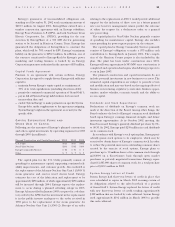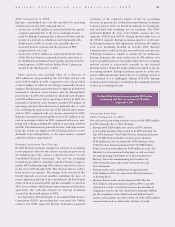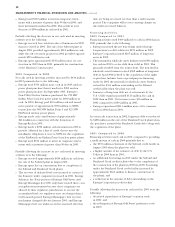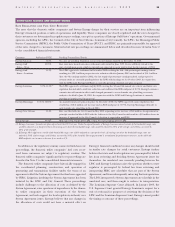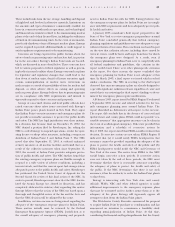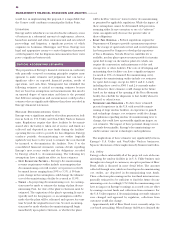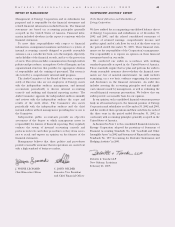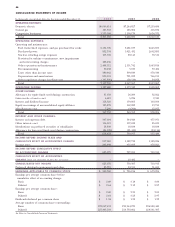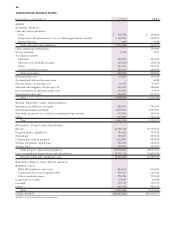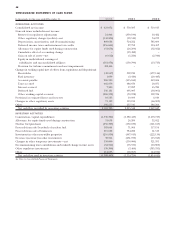Entergy 2002 Annual Report Download - page 41
Download and view the complete annual report
Please find page 41 of the 2002 Entergy annual report below. You can navigate through the pages in the report by either clicking on the pages listed below, or by using the keyword search tool below to find specific information within the annual report.
30% share of River Bend formerly owned by Cajun Electric
Power Cooperative, Inc., Entergy Gulf States obtained decom-
missioning trust funds of $132 million, which have since grown
to almost $150 million. Entergy Gulf States believes that these
funds will be sufficient to cover the costs of decommissioning
this portion of River Bend, and no further collections or
deposits are being made for these costs. Additionally, under the
Deregulated Asset Plan in the Louisiana jurisdiction of Entergy
Gulf States, a portion of River Bend (approximately 16% of its
total capacity) is excluded from rate base, and no amounts
have been or are being collected for decommissioning for this
portion of the plant.
In the U.S. Utility business unit, the obligations recorded by
Entergy for decommissioning are classified either as a compo-
nent of accumulated depreciation (ANO 1 and 2, Waterford 3,
and the regulated portion of River Bend) or as a deferred
credit (System Energy and the nonregulated portion of River
Bend) in the line item entitled “Decommissioning.” The
amounts recorded for these obligations are comprised of col-
lections from customers and earnings on the trust funds. The
classification and recording of these obligations will change
with the implementation of SFAS 143, which is discussed in
more detail below.
Non-Utility Nuclear
In conjunction with the purchase of Entergy’s Non-Utility
Nuclear facilities, Entergy assumed the decommissioning
obligations and received the related decommissioning trust
funds (except for the NYPA acquisition, in which NYPA retained
the decommissioning obligations for the Indian Point 3 and
FitzPatrick units). Based on decommissioning cost studies
and expected plant operation lives, Entergy believes that the
amounts in the trust funds will be sufficient to fund future decom-
missioning costs without additional deposits from Entergy.
As Entergy has assumed these decommissioning obligations
without any further external source of funding, changes in
estimates of decommissioning costs for these units will have a
direct impact on Entergy’s financial position and results of
operations. Upon purchase of the plants, Entergy recorded
obligations that were equivalent to the amounts initially
received in the decommissioning trust funds. These obliga-
tions are recorded as deferred credits in the line item entitled
“Decommissioning.” These obligations are accreted at implicit
discount rates that are determined based upon the estimated
costs of decommissioning. The accounting for these obligations
will change with the implementation of SFAS 143, which is
discussed in more detail below.
SFAS 143
Entergy implemented SFAS 143, “Accounting for Asset
Retirement Obligations,” effective January 1, 2003. Nuclear
decommissioning costs comprise substantially all of Entergy’s
asset retirement obligations, and the measurement and
recording of Entergy’s decommissioning obligations outlined
above will change significantly with the implementation of
SFAS 143. The most significant differences in the measure-
ment of these obligations are outlined below:
RECORDING OF FULL OBLIGATION –SFAS 143 requires that
the fair value of an asset retirement obligation be recorded
when it is incurred. This will cause the recorded decommis-
sioning obligation in Entergy’s U.S. Utility business to
increase significantly, as Entergy had previously only
recorded this obligation as the related costs were collected
from customers, and as earnings were recorded on the
related trust funds.
FAIR VALUE APPROACH –SFAS 143 requires that these
obligations be measured using a fair value approach.
Among other things, this entails the assumption that the
costs will be incurred by a third party and will therefore
include appropriate profit margins and risk premiums.
Entergy’s decommissioning studies to date have been based
on Entergy performing the work, and have not included
any such margins or premiums. Inclusion of these items
increases cost estimates.
DISCOUNT RATE –SFAS 143 requires that these obligations
be discounted using a credit-adjusted, risk-free rate. This
will result in significant decreases in Entergy’s decommis-
sioning obligations in the Non-Utility Nuclear business, as
this discount rate is higher than the implicit rates utilized
by Entergy in accounting for these obligations through
December 31, 2002.
The net effect of implementing this standard, to the extent that
it was not recorded as regulatory assets or liabilities, will be
recognized as a cumulative effect of an accounting change in
Entergy’s 2003 statement of income. Implementation will have
the following effect on Entergy’s financial statements:
The net effect of implementing this standard for the
rate-regulated business of the domestic utility companies
and System Energy will be recorded as regulatory assets
or liabilities, with no resulting impact on Entergy’s net
income. Assets and liabilities are expected to increase by
approximately $1.1 billion in 2003 for the domestic utility
companies and System Energy as a result of recording the
asset retirement obligations at their fair values as determined
under SFAS 143 and recording the related regulatory
assets and liabilities. The implementation of SFAS 143 for
the portion of River Bend not subject to cost-based rate-
making is expected to decrease earnings by approximately
$25 million as a result of a one-time cumulative effect of
accounting change.
For the Non-Utility Nuclear business, the implementation
of SFAS 143 is expected to result in a decrease in liabilities
ENTERGY CORPORATION AND SUBSIDIARIES 2002 39
Federal regulations require the Department of Energy
to provide a permanent repository for the storage of
spent nuclear fuel, and recent legislation has been
passed by Congress to develop this repository at
Yucca Mountain, Nevada.


